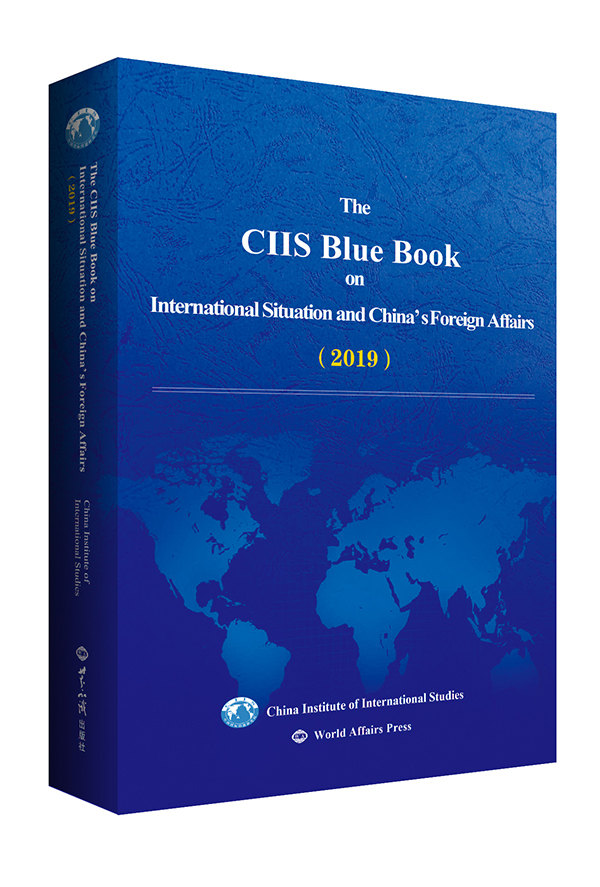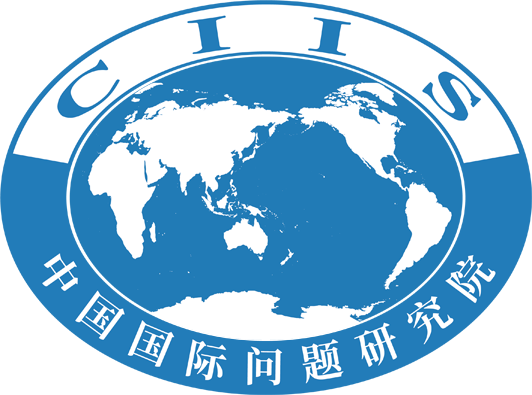
The CIIS Blue Book on International Situation and China’s Foreign Affairs (2019)
China Institute of International Studies
Chief Editor: Qi Zhenhong
World Affairs Press
April 2019
Foreword
Turmoil and changes marked the year 2018, adding to existing uncertainties and instabilities. The great powers were engaged in unprecedented competitions. The influence of nationalism and populism continued to spread. Protectionism and unilateral bullying also raised their heads. The world is descending into disorder. Faced with this complicated international situation, China has firmly followed the path of advancing major country diplomacy with Chinese characteristics to fulfil the mission of achieving national rejuvenation while preserving world peace and pursuing common development to promote the building of a community with a shared future for mankind. China has demonstrated to the world, with its own sustained and stable development and responsible major country diplomatic initiatives, that China has always been an upholder of world peace, a contributor to global development and a maintainer of the international order.
The change of the international pattern has contributed to a profound adjustment of the relations between major powers, which in turn has accelerated the evolution of the international pattern.
At present, the world maintains the “one superpower and multiple great powers” pattern. However, as the one superpower continues to decline, the multiple great powers are increasingly polarized. This trend is mainly reflected in three aspects. First, the distribution of world power develops in favour of the East and the South, with more power transited from the West to the East; Second, it is more difficult for the West to maintain the stranglehold which it used to have on international affairs as the international status and the discursive power of the newly developed market economies and the developing countries are rising; Third, meanwhile a new round of scientific and technological revolution has given non-Western countries an opportunity to get ahead, giving rise to further major changes in the balance of major world powers.
The United States has taken the lead in making strategic adjustments. It has taken the initiative to reconstruct the international order, practicing power politics as it makes full use of its superior strength, thereby consolidating its dominant position.
This adjustment of the U.S. has led to unprecedented competition among the major powers in the fields of economy, trade, science and technology, security, rules and order, and regional and multilateral diplomacy. The European Union, Russia, Japan and India etc. have also sped up the adjustments of their own foreign policies, seeking paths of both struggle and compromise alongside the U.S. while forming partnerships among themselves to increase cooperation in order to reduce risk and pressure.
This development of the relations of the world powers has led to a cross-collision of forces in world politics. Competitions and struggle between developing countries and developed countries, between developing countries and even between developed countries have intensified. The competitive interaction between the U. S. as the one existing superpower and the rest of the major powers of the world has also become more pronounced, with the EU and Japan more willing to pursue their own agenda. In addition, power contests between the U.S. and the newly emerged economies are increasingly obvious. However, no matter how the strength of the U.S. and the major countries rise or fall, or the power distribution of the developing and the developed world changes, the world stays on the track towards multi-polarization.
At the same time, the strategic readjustment of the U.S. has led to a rise of protectionism and populism, creating stumbling blocks for globalization with multilateralism and the free trade system suffering terribly as a result. As the world economy faces increased downward pressure, the global governance mechanism is in risk of “fragmentation” and “factionization”.
Faced with the biggest changes in the international pattern in the past 100 years, under the strong leadership of the CPC Central Committee with President Xi Jinping at its core, China has maintained strategic self-confidence, upheld its strategic strength, and kept a strategic resolve. Adopting President Xi Jinping Thought on Diplomacy as the fundamental principle and action guide for its diplomatic moves, China holds high the banner of building a community with a shared future for mankind, commits to its international obligations as a responsible major world power and injects much needed positive energy into a world fraught with uncertainty.
China has made important contributions to the overall stability of the international community and become an important force for stability and development in the world. In response to the U. S. strategic adjustments, China has sought to protect its own interest while responding to the expectations of other countries. China is committed to resolve its economic and trade frictions with the U.S. through dialogue and negotiation and work with the U. S. to develop a bilateral relationship of coordination, cooperation and stability. Meanwhile, China continues to work with Russia to ensure that the comprehensive strategic partnership of coordination between the two countries remain on a high level in this new phase of world development. With China and Russia committed to their side by side and back to back strategic coordinative partnership, the two counties serve as anchors for world strategic balance and stability. China and the EU have further deepened their comprehensive strategic partnership for mutual benefit and win-win cooperation, consolidating the foundation of China-EU cooperation. China’s relationship with Japan and India are back on track, creating a new momentum for bilateral relations with the two countries. China’s relations with other countries are also progressing steadily. The Chinese economy maintained a medium to high speed of growth in 2018, recording a 6.6% GDP growth. China’s total economy surpassed 90 trillion yuan at the end of 2018, with a total trade volume of over 30 trillion yuan for the year. China’s sustained and stable development proves that it is still the most important engine of world economic growth and an important driving force in international development.
China’s participation is pushing the global governance towards a more just and rational direction, making China an important force in safeguarding the international order. Over the past year, with building a community with a shared future for mankind as its ultimate goal, China has been promoting mutually beneficial cooperation with other countries so all can share the development gains. The idea of “a community with a shared future for mankind” has been written into many high-level bilateral and multilateral diplomatic documents, winning wide acceptance. In diplomacy, China advocates more handshakes, less fists, more heart-to-heart exchanges, and less hand-to-hand combats. It actively explores a new diplomatic path of dialogue without confrontation companionship without alignment, bond and not grudge, steadily promoting the construction of new international relations. China actively participates in leading the direction of global governance evolution and resolutely upholds rules-based multilateralism. President Xi has voiced his support for globalization on many multilateral diplomatic platforms, including the BRICS summit, APEC summit and G20 summit, while repeatedly speaking out against protectionism and unilateralism in any form. He has always insisted that China is committed to protecting a world order and system with the purposes of The UN Charter at its core, firm in its support for a free, open and encompassing multilateral trading system, and shall endeavour to maintain the authority of the WTO rules. China continues to push for a more fair and just global governance system and has proven to be a pillar of strength and stability in a world of chaos.
China, constantly reassuring the world of its intention of expanding its door-open policy, has become an important leading force for openness in the world. President Xi has reiterated China’s commitment to reforms and opening-up policy on many important occasions such as the Conference Commemorating the 40th Anniversary of Reform and Opening-up, the first China International Import Expo, the Boao Forum for Asia etc., announcing a series of important moves to open China wider to the outside world. This shows that China is determined to stay on the side of historical progress, taking practical actions to support multilateral and free trade promoting and adapting to economic globalization. It also provides China with a helpful protection against outside risks and challenges while it endeavours to build socialism with Chinese characteristics.
China has continuously promoted cooperation with all parties and has become an important force in promoting international cooperation. China’s Belt and Road Initiative has achieved great success with more than 60 countries and international organizations signing cooperation documents with China in 2018, pushing the total number close to 170. 2018 is a year of south-south cooperation for Chinese diplomacy, with the China-Arab, China-Latin America and China-Africa forums all held within the year in Beijing, witnessing the full coverage of the collective dialogue between China and other developing countries. Also in 2018, President Xi selected the Middle East and Africa as the destinations of his first overseas visit of the year. At the end of the year, he met with the leaders or government representatives of eight pacific island states which have diplomatic relations with China in Papua New Guinea. These major diplomatic moves have vigorously promoted China’s solidarity and cooperation with developing countries, pushing their relations to a new level.
China has always sought to resolve international issues in its own style, making it an important force in guarding regional and world peace. China believes in the power of political talks and has always encouraged the ROK and the DPRK to seize all possible opportunities to improve their relations, and support the reopening of talks between the U.S. and the DPRK and hope it will lead to mutual trust. China is also working with all parties to safeguard and implement the comprehensive agreement on the Iran nuclear issue, proposed a three-stage solution to resolving the issue of the Rakhine State in Myanmar, established a dialogue mechanism between the Chinese Afghan and Pakistani foreign ministers, and is mediating in other international hotspots such as Syria and Palestine, proving its commitment to world peace.
The world situation is to be grimmer and more complex in 2019. But peace and development are aspired by all. That’s a fact which will not be changed by any person or state. The tide of international events is irresistible. Only those who go with the tide can prosper; those who try to go against the tide will surely perish. 2019 is the 70th anniversary of the founding of the People’s Republic of China, and it has been 70 years of great changes. Guided by President Xi Jinping’s Thought on Diplomacy, China will continue to pursue major country diplomacy with Chinese characteristics. On the threshold of a new historic era, China is to forge ahead, despite difficulties and challenges, to make even greater contributions to the rejuvenation of the Chinese nation and the progress of mankind.
The CIIS Blue Book on International Situation and China’s Foreign Affairs is an annual publication released by the China Institute of International Studies (CIIS) since 2006. It contains essays of in-depth analysis and comprehensive interpretation of the international situation and China’s diplomacy. We hope our studies are helpful to researchers of international issues, and readers interested in China’s diplomacy, and provide a Chinese perspective for people outside China who want to learn more about the country and its relationship with the world.
This book is a result of collective wisdom of the authors and the reviewers, who all devoted themselves to the making of the book. I would like to thank Dr. Ruan Zongze and Mr. Dong Manyuan, Executive Vice President and Vice President of CIIS respectively, for their excellent work as reviewers-in-charge. I would also like to thank Dr. Chen Xulong, Director of Department for International and Strategic Studies, Ms. Su Xiaohui, Deputy Director of Department for International and Strategic Studies, Dr. Zhu Zhongbo, Dr. Yang Chenxi, Mr. Zhang Kun and Mr. Xu Ke for their work in selecting and editing the essays and coordination efforts that made the publication of this book possible. Gratitude is also due to the World Affairs Press Co. Ltd., whose efficient and rigorous proofing work added value to the book. Last but not least, please allow me to express my gratitude to you our readers. Thank you for your consistent encouragement and support. Your critiques and suggestions are of great value to us and we welcome them.
Qi Zhenhong
President of China Institute of International Studies CIIS
February 2019, Beijing
Contents
Foreword……Qi Zhenhong 7
Part Ⅰ
The International Situation in 2018
Chapter 1 Section 1
Situation in the United States: Who Will Restrain Trump……Shen Yamei 3
Chapter 1 Section 2
Situation in Russia: Stability with Minor Fluctuations No Major Changes in Pattern…… Li Ziguo 24
Chapter 1 Section 3
Situation in Europe: Trapped in Harsh Predicaments Integration Process Slowing Down......Jin Ling 45
Chapter 1 Section 4
Situation in Japan: Seeking Progress Steadily and Making the Best of All Sides……Jin Linbo 63
Chapter 2 Section 1
Situation in Southeast Asia: Changing Politics and Stable Economy…...Liu Chang 82
Chapter 2 Section 2
Situation in South Asia: Political Upheavals and Intensified Geopolitical Wrestling……Lan Jianxue 103
Chapter 2 Section 3
Situation in Central Asia: With Keynote on Regional Cooperation and Focus on Economic Diplomacy……Cheng Min 121
Chapter 2 Section 4
Situation in Latin America: New Political Landscape in the Election Year……Wang Youming 142
Chapter 2 Section 5
Situation in Africa: Coexistence of Increasing Autonomy and Development Challenges……Zeng Aiping 159
Chapter 2 Section 6
Situation in the Middle East: Growing Complexities in Power Play……Dong Manyuan 179
Chapter 3 Section 1
World Economy: Continued Growth Prominent Divergences……Li Xiaoyu 203
Chapter 3 Section 2
Global Governance: Increasing Difficulty with Partial Progress……Yang Chenxi 220
Chapter 3 Section 3
Situation of International Terrorism and Counter-Terrorism Cooperation: Threats Rising again with Hidden Risks Increasing…...Gu Ning 243
Chapter 3 Section 4
Situation on Korean Peninsula: Turning Point Occurred with Remaining Challenges……Wu Jingjing 262
Chapter 3 Section 5
U.S.-Iran Relations and Iran Nuclear Deal……Li Guofu 282
Part Ⅱ
China’s Foreign Affairs in 2018
Chapter 1 Section 1
China’s Diplomacy: Starting a New Voyage……Ruan Zongze 305
Chapter 1 Section 2
China’s Relations with Major Countries……Xu Jian 325
Chapter 1 Section 3
Neighborhood Diplomacy: All-Round Improvement with Potential Challenges……Su Xiaohui 343
Chapter 1 Section 4
China’s Relations with Developing Countries: Building Consensus on Development and Leading South-South Cooperation……Ning Shengnan 364
Chapter 1 Section 5
Multilateral Diplomacy: Advocating Openness and Multilateralism……Chen Xulong 380
Chapter 2 Section 1
China-U.S. Relations: At the Crossroad……Cui Lei 405
Chapter 2 Section 2
China-Russia Relations: Continuous Development at a High Level……Zhao Mingwen 427
Chapter 2 Section 3
China-EU Relations: Forging Ahead While Maintaining Stability, Seeking Common Ground While Managing Divergences……Cui Hongjian 450
Chapter 2 Section 4
China-Japan Relations: Returned to Track with Difficulties……Jiang Yuechun 476
Chapter 2 Section 5
China-India Relations: Establishing an Important Milestone and Entering a New Era……Tang Qifang 496
Chapter 2 Section 6
China-ASEAN Relations: Entering the New Era and Composing a New Chapter……Song Junying 515
Chapter 2 Section 7
China’s Relations with Central Asian Countries: Developing at a High Level Aiming for Steady and Sustained Progress……Zhao Zhen 537
Chapter 2 Section 8
China-Africa Relations: Forging Ahead with Determinations and Aiming for Steady and Sustained Progress……He Rui 556
Chapter 2 Section 9
China-LAC Relations Stable Progress amid Rising Challenges……Wang Huizhi 581
Chapter 2 Section 10
China-Arab Relations: New Opportunities and New Challenges……Wang Zesheng 599
Chapter 2 Section 11
China-South Pacific Relations: Forging Ahead Against Headwinds……Zhu Zhongbo 615
Chapter 3 Section 1
International Economic Relations: Accelerating Opening-Up, Promoting Multilateralism……Zhang Mei 636
Chapter 3 Section 2
International Security Cooperation: Commitments and Contributions……Xu Longdi 652
Chapter 3 Section 3
Public Diplomacy: Taking Initiative to Shape Perceptions and Actively Dealing with Challenges…… Zhang Weiwei 676



